The Intel Optane Memory (SSD) Preview: 32GB of Kaby Lake Caching
by Billy Tallis on April 24, 2017 12:00 PM EST- Posted in
- SSDs
- Storage
- Intel
- PCIe SSD
- SSD Caching
- M.2
- NVMe
- 3D XPoint
- Optane
- Optane Memory
BAPCo SYSmark 2014 SE
BAPCo's SYSmark 2014 SE is an application-based benchmark that uses real-world applications to replay usage patterns of business users in the areas of office productivity, media creation and data/financial analysis. In addition, it also addresses the responsiveness aspect which deals with user experience as related to application and file launches, multi-tasking etc. Scores are meant to be compared against a reference desktop (the SYSmark 2014 SE calibration system in the graphs below). While the SYSmark 2014 benchmark used a Haswell-based desktop configuration, the SYSmark 2014 SE makes the move to a Lenovo ThinkCenter M800 (Intel Core i3-6100, 4GB RAM and a 256GB SATA SSD). The calibration system scores 1000 in each of the scenarios. A score of, say, 2000, would imply that the system under test is twice as fast as the reference system.
SYSmark scores are based on total application response time as seen by the user, including not only storage latency but time spent by the processor. This means there's a limit to how much a storage improvement could possibly increase scores. It also means our Optane review system starts out with an advantage over the SYSmark calibration system due to the faster processor and more RAM.



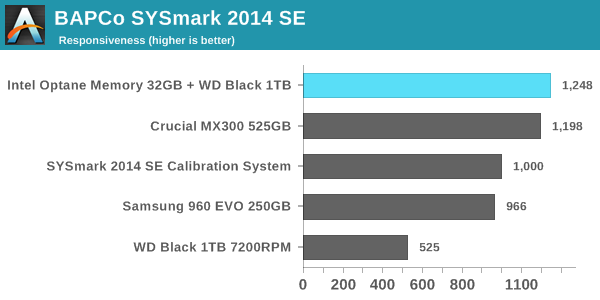
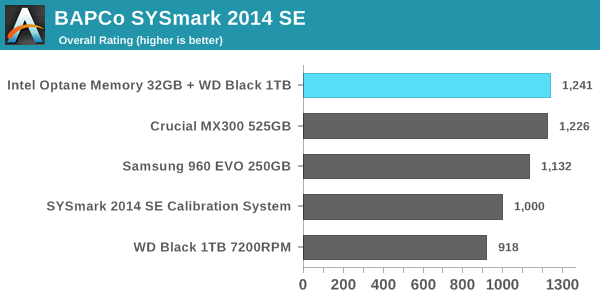
In every performance category the Optane caching setup is either in first place or a close tie for first. The Crucial MX300 is tied with the Optane configuration for every sub-test except the responsiveness test, where it falls slightly behind. The Samsung 960 EVO 250GB struggles, partly because its low capacity and the low degree of parallelism that implies means it often cannot take advantage of the performance offered by its PCIe 3.0 x4 interface. The use of Microsoft's built-in NVMe driver instead of Samsung's may also be holding it back. As expected, the WD Black hard drive scores substantially worse than our solid-state configurations on every test, with the biggest disparity occurring in the responsiveness test: The WD Black hard drive will force users to spend more than twice as much time waiting on their computer than if it has a SSD.
Energy Usage
SYSmark 2014 SE also adds energy measurement to the mix. A high score in the SYSmark benchmarks might be nice to have, but, potential customers also need to determine the balance between power consumption and the efficiency of the system. For example, in the average office scenario, it might not be worth purchasing a noisy and power-hungry PC just because it ends up with a 2000 score in the SYSmark 2014 SE benchmarks. In order to provide a balanced perspective, SYSmark 2014 SE also allows vendors and decision makers to track the energy consumption during each workload. In the graphs below, we find the total energy consumed by the PC under test for a single iteration of each SYSmark 2014 SE workload and how it compares against the calibration systems.
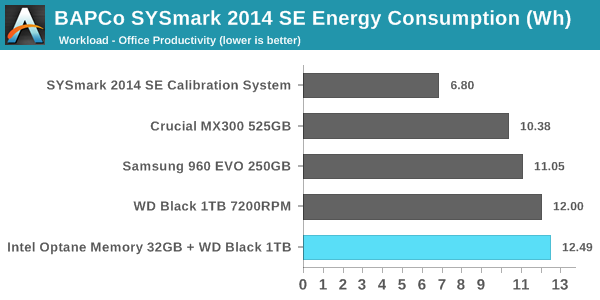
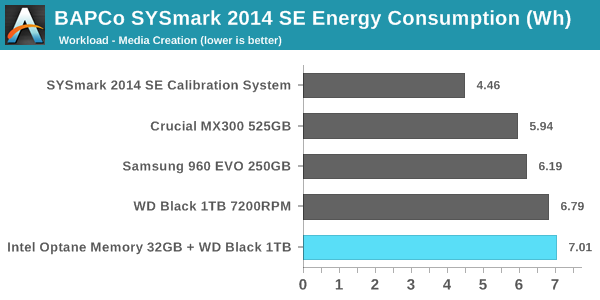
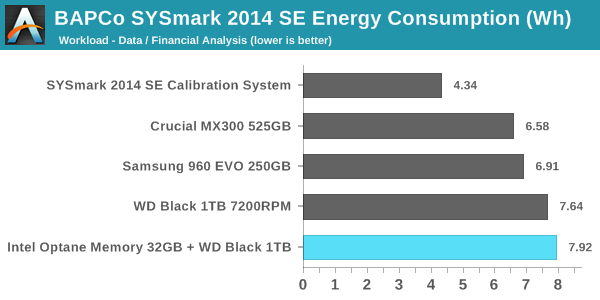
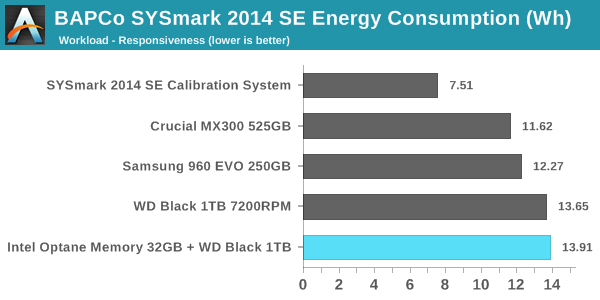
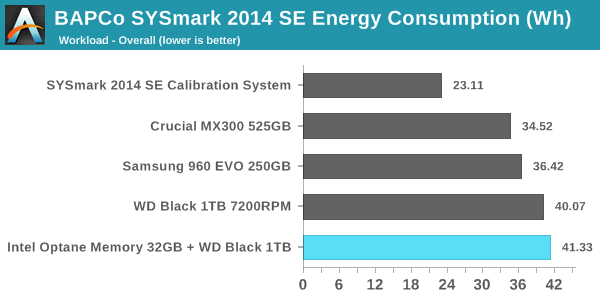
The peak power consumption of a PCIe SSD under load can exceed the power draw of a hard drive, but over the course of a fixed workload hard drives will always be less power efficient. SSDs almost always complete the data transfer sooner, and they can enter and leave their low-power idle states far quicker. On a benchmark like SYSmark, there are no idle times long enough for a hard drive to spin down and save power.
With an idle power of 1W, the Optane cache module substantially increases the already high power consumption of the hard drive-based configurations. It does allow for the tests to complete sooner, but since the Optane module does nothing to accelerate the compute-bound portions of SYSmark, the total time saved is not enough to make up the difference. It also appears that the Optane caching is not being used to enable more aggressive power saving on the hard drive—Intel's probably flushing writes from the cache often enough to keep the hard drive spinning the whole time. What this adds up to is a difference that's quite clear but not big enough for desktop users to be too concerned with unless their electricity prices are high. The Optane Memory caching configuration is the most power-hungry option we tested, while the second-place performing Crucial MX300 configuration was most efficient, using about 16% less energy overall.
For mobile users, the power consumption of the Optane plus hard drive configuration is pretty much a deal-breaker. Our Optane review system is not optimized for power consumption the way a notebook system would be, so for a mobile user the Optane module would account for an even larger portion of the total battery draw, and battery life will take a serious hit.










110 Comments
View All Comments
romrunning - Monday, April 24, 2017 - link
Speaking of real-world tests, I am waiting for SQL Server tests on an Optane SSD - like on that DC P4800X. The "enterprise" review of the 4800 was all synthetic benchmarks with some disclaimer that they can't simulate all enterprise loads. Sure, you can't simulate everything, but I'm very disappointed that -nothing- enterprise level was even tested.ddriver - Monday, April 24, 2017 - link
I am sure it is just an unfortunate coincidence, and it is not like intel is trying to hide the actuality of real world performance :)darkfalz - Monday, April 24, 2017 - link
SSD cache / Hybrid SSD drives work okay on certain workloads, mainly productivity stuff, but if you have a lot of games/media they tend to fill up really quickly and I don't think any of the companies that write the algorithms, Intel included, can really figure out how reliably and over long usage periods decide what should be in the cache and what shouldn't.I have a 24GB SSD cache (ExpressCache) in my Notebook and I partitioned the OS/Programmes for to one partition, and put all the media on the second partition, and set it to only cache the first partition. This setup works pretty well.
I also have a Hybrid SSHD in another laptop (only 8GB I think) that I mostly use as a background downloading PC, and after a few days of doing this any useful boot / OS / Chrome stuff that was in the cache has been evicted and it's back to booting at the same speed as a regular HDD.
Nice in theory, highly variable in practice. I never tried the Intel SRT out because larger SSD affordability improved a lot after it was released.
satai - Monday, April 24, 2017 - link
Can I just put it into a PCIe slot (via a reduction), boot linux from an other SSD drive and use it as any other block device?romrunning - Monday, April 24, 2017 - link
Per the article: "However, the Optane Memory can also be treated as a small and fast NVMe SSD, because all of the work to enable its caching role is performed in software or by the PCH on the motherboard. 32GB is even (barely) enough to be used as a Windows boot drive, though doing so would not be useful for most consumers."DigitalFreak - Monday, April 24, 2017 - link
Are you also going to test Intel SRT with a ~$77 SATA SSD and the same WD HDD? I bet it would perform about the same, and SRT works with non-boot drives.eddieobscurant - Monday, April 24, 2017 - link
How about using the same test setup as with the other ssds and run the same benchmarks for comparison?I get you wanna please intel for giving you access to optane (which should be named remote preview by the way) , but come on !!!
Also the new graphs ( probably suggested from intel , since tomshardware has something like these ) are not easy to understand with a quick look.
Billy Tallis - Monday, April 24, 2017 - link
These two Optane reviews interrupted my work on putting together a new 2017 consumer SSD test suite to replace our aging 2015 suite. When the new test suite is ready, you'll get comparisons against the broad range of SSDs that you're used to seeing and more polished presentation of the data.Shadowmaster625 - Monday, April 24, 2017 - link
Can this be used as a boot drive?romrunning - Monday, April 24, 2017 - link
Per the article: "However, the Optane Memory can also be treated as a small and fast NVMe SSD, because all of the work to enable its caching role is performed in software or by the PCH on the motherboard. 32GB is even (barely) enough to be used as a Windows boot drive, though doing so would not be useful for most consumers."